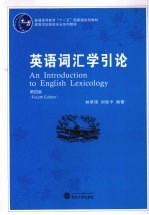

英语词汇学引论PDF电子书下载
- 电子书积分:15 积分如何计算积分?
- 作 者:林承璋,刘世平编著
- 出 版 社:武汉:武汉大学出版社
- 出版年份:2009
- ISBN:9787307068834
- 页数:452 页
Chapter 1 Language,Linguistics and Lexicology 1
1-1-1 Introductory Remarks 1
1-1-2 A Definition of Language 1
1-1-3 Language,Society and Thought 2
1-2-1 A Definition of Linguistics 5
1-2-2 The Scope of Linguistics 5
1-3-1 What Is Lexicology? 6
1-3-2 Aims and Significance of the Course of English Lexicology 6
1-3-3 The Connection of Lexicology with Other Branches of Linguistics 7
1-3-4 Two Approaches to the Study of English Lexicology 8
Chapter 2 The Sources of the English Vocabulary 13
2-1-1 What is Etymology? 13
2-1-2 The English People and the English Language 14
2-1-3 The Position and Character of the English Language in the Indo-European Family 14
2-1-4 The Divisions of the History of the English Language 15
2-1-5 Some Characteristics of Old English 15
2-1-6 Some Characteristics of Middle English 20
2-1-7 Some Characteristics of Modern English 23
2-1-8 Etymological Twins in English 30
2-1-9 Some Combining Forms Used in Modern English 32
2-2-1 Words of Native Origin 39
2-2-2 Borrowed Words in the English Vocabulary 41
2-3-1 The Foreign Elements in the English Vocabulary 44
2-3-2 The Scandinavian Element in the English Vocabulary 44
2-3-3 The French Element in the English Vocabulary 46
2-3-4 The Latin Element in the English Vocabulary 49
2-3-5 The Greek Element in the English Vocabulary 52
2-3-6 The Influence of the Classical Elements upon the English Vocabulary 53
2-3-7 Other Foreign Elements in the English Vocabulary 55
2-3-8 The Interrelation Between the Native and Foreign Elements in the English Vocabulary 57
2-3-9 The Linguistic and Historical Origins of Some Common English Words 58
Chapter 3 Word Meaning and Semantic Relations 67
3-1-1 Some General Remarks on Semantics and Meaning 67
3-1-2 The Relationship Between Meaning and theObject 70
3-2-1 What Is a Word? 71
3-2-2 Meaning and Motivation 72
3-3-1 Classifications of Words 73
3-3-2 Main Types of Word Meaning 76
3-3-3 Word Meaning and Context 80
3-4-1 Synonyms 83
3-4-2 Antonyms 89
3-4-3 Polysemy and Homonymy 93
3-4-4 Hyponymy 100
Chapter 4 The Changing English Voca bulary 103
4-1-1 The Constant Change in Language and the Continuous Appearance of Neologisms 103
4-1-2 The Definition of Neologisms or New Words 104
4-1-3 The Rate of Changes of the English Vocabulary 106
4-1-4 The Sources of New Words 106
4-1-5 The Formation of Neologisms 126
4-2-1 Archaisms 137
4-3-1 Changes in Meaning 141
4-3-2 Four Tendencies in Semantic Changes 143
4-3-3 Semantic Changes from the Literal Use of Words to Their Figurative Use 152
Chapter 5 Word-formation in English 168
5-1-1 Introduction 168
5-1-2 Morphological Structure of Words 168
5-1-3 Two Types of Morphemes 169
5-1-4 Three Types of Words 170
5-1-5 Root,Base,Stem 171
5-2-1 The Main Processes of English Word-formation 177
5-2-2 The Minor Processes of English Word-formation 259
Chapter 6 English Idioms 273
6-1-1 Introduction 273
6-1-2 The Definition of Idioms 273
6-1-3 The Significance of Studying English Idioms 275
6-1-4 The Features of English Idioms 275
6-1-5 English Idioms in Different Styles 279
6-1-6 The Difference Between Idiomatic and Free Phrases 281
6-2-1 Classifications of English Idioms 282
6-2-2 Some Useful Language Areas of Idioms 301
Chapter 7 English Collocations 320
7-1-1 Introduction 320
7-1-2 What Is a Collocation? 320
7-1-3 The Importance of Learning English Collocations 321
7-2-1 The Classification of English Collocations 324
7-2-2 Register Used in English Collocations 341
7-3-1 Some Commonest Words Used in English Collocations. 342
7-4-1 Different Subjects of English Collocations 347
7-4-2 Families 348
7-4-3 Houses,Flats and Rooms 350
7-4-4 Food and Drink 357
7-4-5 Study and Learning 358
7-4-6 Fitness and Illness 359
7-4-7 Job and Work 361
7-4-8 Computers 366
7-4-9 Sport 368
7-4-10 Time 372
Chapter 8 British and American English 375
8-1-1 English as a Language of Worldwide Use 375
8-1-2 British and American English 376
8-1-3 The Historical Background of American English 379
8-2-1 Differences between British English and American English 381
8-2-2 Differences in Individual Sounds 381
8-2-3 Differences in Stress 383
8-2-4 Differences in Spelling 384
8-2-5 Differences in Vocabulary 385
8-2-6 Differences in Grammar 396
8-3-1 A Comparison Between Webster's Pronunciation Symbols(WPS)and International Phonetic Alphabet(IPA) 399
8-3-2 British and American English in the Future 409
Chapter 9 English Dictionaries and How to Use Them 410
9-1-1 What Is a Dictionary? 410
9-1-2 Characteristics of Dictionaries 412
9-2-1 Types of Dictionaries 413
9-2-2 Monolingual,Bilingual and Multilingual Dictionaries 414
9-2-3 General and Special Dictionaries 414
9-2-4 Pocket,Medium-sized and Unabridged Dictionaries 416
9-2-5 Synchronic and Diachronic Dictionaries 416
9-2-6 Encyclopedias and Encyclopedic Dictionaries 417
9-2-7 The Printed and Electronic Dictionaries 418
9-3-1 The History of English Dictionaries 419
9-3-2 A Brief Introduction of Five Newest English Dictionaries 422
9-3-3 Five Periods in the History of English Dictionaries 428
9-4-1 How to Use English Dictionaries 429
Appendix 1 An English-Chinese List of Technical Terms of Lexicology Used in This Book 437
Appendix 2 The Review of a Newest Book 446
Bibliography 447
- 《汉语词汇知识与习得研究》邢红兵主编 2019
- 《法语词汇认知联想记忆法》刘莲编著 2020
- 《《国语》和《战国策》词汇比较研究》陈长书著 2017
- 《高中英语词汇考试指导》徐志江编著 2019
- 《新课标初中英语词汇同步速记 八年级 上 通用版》蔡波主编 2018
- 《新课标初中英语词汇同步速记 九年级 全1册》蔡波编 2018
- 《说文解单词 高中英语词汇4000》余锦华,徐嘉 2019
- 《计算机自适应英语语用能力测试系统设计与效度验证 以TEM4词汇与语法题为例》张一鑫著 2019
- 《牛津学术英语词汇精练 基础篇》Julie Moore 2019
- 《高中英语中译英 语法分类·核心词汇》(中国)查天恩 2019
- 《市政工程基础》杨岚编著 2009
- 《家畜百宝 猪、牛、羊、鸡的综合利用》山西省商业厅组织技术处编著 1959
- 《《道德经》200句》崇贤书院编著 2018
- 《高级英语阅读与听说教程》刘秀梅编著 2019
- 《计算机网络与通信基础》谢雨飞,田启川编著 2019
- 《看图自学吉他弹唱教程》陈飞编著 2019
- 《法语词汇认知联想记忆法》刘莲编著 2020
- 《培智学校义务教育实验教科书教师教学用书 生活适应 二年级 上》人民教育出版社,课程教材研究所,特殊教育课程教材研究中心编著 2019
- 《国家社科基金项目申报规范 技巧与案例 第3版 2020》文传浩,夏宇编著 2019
- 《流体力学》张扬军,彭杰,诸葛伟林编著 2019
- 《大学计算机实验指导及习题解答》曹成志,宋长龙 2019
- 《大学生心理健康与人生发展》王琳责任编辑;(中国)肖宇 2019
- 《大学英语四级考试全真试题 标准模拟 四级》汪开虎主编 2012
- 《大学英语教学的跨文化交际视角研究与创新发展》许丽云,刘枫,尚利明著 2020
- 《复旦大学新闻学院教授学术丛书 新闻实务随想录》刘海贵 2019
- 《大学英语综合教程 1》王佃春,骆敏主编 2015
- 《大学物理简明教程 下 第2版》施卫主编 2020
- 《大学化学实验》李爱勤,侯学会主编 2016
- 《中国十大出版家》王震,贺越明著 1991
- 《近代民营出版机构的英语函授教育 以“商务、中华、开明”函授学校为个案 1915年-1946年版》丁伟 2017
